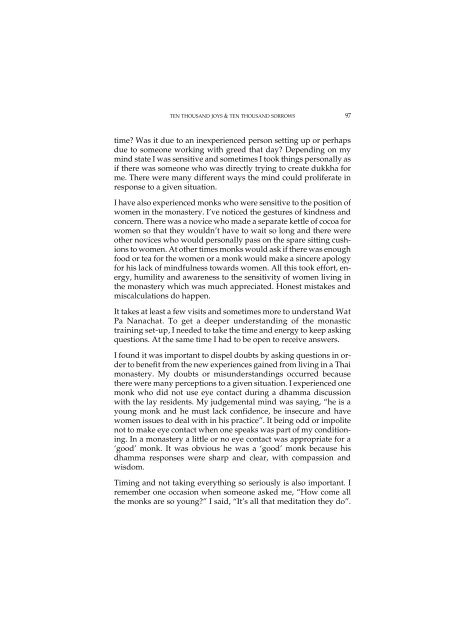Forest Path - Amaravati Buddhist Monastery
Forest Path - Amaravati Buddhist Monastery
Forest Path - Amaravati Buddhist Monastery
Create successful ePaper yourself
Turn your PDF publications into a flip-book with our unique Google optimized e-Paper software.
ten thousand joys & ten thousand sorrows 97<br />
time? Was it due to an inexperienced person setting up or perhaps<br />
due to someone working with greed that day? Depending on my<br />
mind state I was sensitive and sometimes I took things personally as<br />
if there was someone who was directly trying to create dukkha for<br />
me. There were many different ways the mind could proliferate in<br />
response to a given situation.<br />
I have also experienced monks who were sensitive to the position of<br />
women in the monastery. I’ve noticed the gestures of kindness and<br />
concern. There was a novice who made a separate kettle of cocoa for<br />
women so that they wouldn’t have to wait so long and there were<br />
other novices who would personally pass on the spare sitting cushions<br />
to women. At other times monks would ask if there was enough<br />
food or tea for the women or a monk would make a sincere apology<br />
for his lack of mindfulness towards women. All this took effort, energy,<br />
humility and awareness to the sensitivity of women living in<br />
the monastery which was much appreciated. Honest mistakes and<br />
miscalculations do happen.<br />
It takes at least a few visits and sometimes more to understand Wat<br />
Pa Nanachat. To get a deeper understanding of the monastic<br />
training set-up, I needed to take the time and energy to keep asking<br />
questions. At the same time I had to be open to receive answers.<br />
I found it was important to dispel doubts by asking questions in order<br />
to benefit from the new experiences gained from living in a Thai<br />
monastery. My doubts or misunderstandings occurred because<br />
there were many perceptions to a given situation. I experienced one<br />
monk who did not use eye contact during a dhamma discussion<br />
with the lay residents. My judgemental mind was saying, “he is a<br />
young monk and he must lack confidence, be insecure and have<br />
women issues to deal with in his practice”. It being odd or impolite<br />
not to make eye contact when one speaks was part of my conditioning.<br />
In a monastery a little or no eye contact was appropriate for a<br />
‘good’ monk. It was obvious he was a ‘good’ monk because his<br />
dhamma responses were sharp and clear, with compassion and<br />
wisdom.<br />
Timing and not taking everything so seriously is also important. I<br />
remember one occasion when someone asked me, “How come all<br />
the monks are so young?” I said, “It’s all that meditation they do”.

















